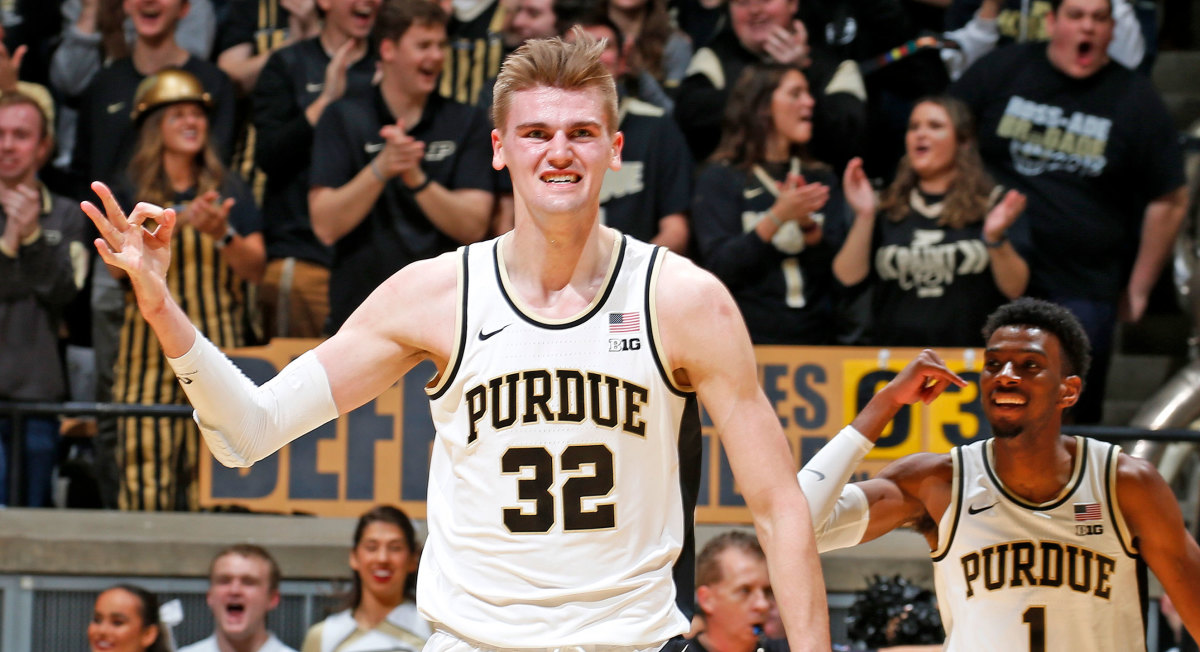Matt Haarms Picks BYU, Complicating Kentucky's Search for a Center
Coveted Purdue grad transfer Matt Haarms picked BYU on Thursday, delivering a big win for the Cougars and a tough blow to his other two finalists, Kentucky and Texas Tech.
The 7’ 3” Haarms was a hot commodity on the transfer market ever since his surprising March announcement that he was leaving the Boilermakers after three years. After seeing his minutes decrease down the stretch in favor of sophomore center Trevion Williams, Haarms made the decision to spend his final year of NCAA eligibility elsewhere, citing the need for "a change of scenery."
All three of Haarms’s finalists were in the hunt for a center for 2020–21, with BYU needing to replace star big man Yoeli Childs, who averaged 22.2 points and was one of the WCC’s best rebounders. Haarms, who averaged 8.6 points as a junior and 9.4 as a sophomore, isn’t the offensive juggernaut that Childs was, but his slender frame could translate better offensively away from the Big Ten, which was stocked with strong, elite centers last season. Despite his size, Haarms is capable in both the midrange and from three, shooting 31.2% in a limited perimeter role as a junior.

The 7-footer’s biggest impact, though, is likely to come on the defensive end and on the boards. Haarms ranked in the 95th percentile on Synergy Sports for overall defense last season, particularly excelling when defending post-ups. He also led the Big Ten in block rate during conference play, landing ninth nationally for the season.
While landing Haarms is a significant gain for BYU, it leaves Kentucky and Texas Tech on less solid ground. The Wildcats in particular could be a team that’s a center away from being one of the top favorites to win the national title (they ranked No. 6 in SI's Way-Too-Early Top 25), but they are now left still scrambling after missing out on their top transfer target.
After the departures of Nick Richards, EJ Montgomery and Nate Sestina, only incoming freshmen 6’9” power forwards Isaiah Jackson and Lance Wear (both top-40 recruits) stand as traditional frontcourt options for John Calipari (6' 7" sophomore Keion Brooks is capable of playing the four as well). Kentucky did also recently land Rhode Island transfer forward Jacob Toppin (brother of Wooden Award-winning Obi), but he will have to sit out a year unless the NCAA votes this spring to allow a one-time transfer for all student-athletes.
With all five starters off to the NBA and an incoming No. 1 recruiting class heavy on guards and wings—including five-stars Terrence Clarke, BJ Boston and Devin Askew—Calipari is attempting to use the transfer market for the second straight year to shore up the frontcourt. Last April, Kentucky landed Sestina from Bucknell, and he played a key reserve role on the 2019–20 Wildcats.
With Haarms off the market, there are limited impact big men still currently available in the portal—however, Calipari could also try to fill the void with a high school recruit, particularly if one reclassifies from 2021, or simply attempt to play smaller next season. A freshman, however, won’t provide the kind of veteran experience Haarms would have brought to an extremely young Wildcats roster in 2020–21 (outside Creighton grad transfer Davion Mintz and Brooks, the rest of the team’s expected contributors are currently all freshmen).
There is one other potential ace in the hole, though, for Kentucky, Texas Tech and any other teams still looking to make a notable roster move for next season: The NCAA’s vote on the transfer rule. On May 20, the governing body is expected to rule on whether all student-athletes will be granted the ability to transfer one time without needing to sit out a season. If the rule passes—and if it goes into effect immediately—it could create a second wave of the transfer market this spring and summer, affording teams a new opportunity to grab an instant impact player. Of course, that could work both ways, with many coaches also potentially needing to fill a roster hole in late spring.
